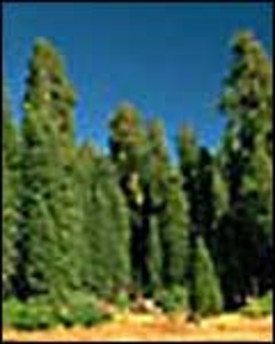 |
||
|
|
After paying your heating bills this winter, you may want to think about planting windbreaks – for landscaping that saves energy dollars.
Winter winds are strong and cold, so when they blow on people or on buildings they pull the heat right out of them. That’s the essence of the wind chill factor we hear about on the weather reports each night.
We all know that sun through the southern windows warms us in winter, but we don’t always remember that blocking the wind can save energy too. The statistics of how much can be saved are noteworthy.
A well placed windbreak can reduce wind velocity by 85%, and reduce winter heating costs by 10% to 25%.
Windbreaks work either by deflecting the wind up and over a building thereby forming a protective wind shadow, or by catching it in the twigs and branches of a double or triple row of trees which breaks up its speed.
Tests done on the western prairies showed that a good windbreak gives best wind shadow protection downwind (where the wind blows to) for a distance 3 to 5 times the height of the trees. It also blocks the wind a short distance upwind (where the wind blows from).
A Wind Shadow
 |
||
|
An evergreen windscreen breaks the force of the wind and creates a protective wind shadow in front and behind. Dead air space protects the house.
|
Another way to lower the wind chill on a house is to put a row of evergreen shrubs right in front of the wall. They will stop the wind and form a protective dead air space between themselves and the wall. When that space fills with snow, it acts as insulation saving even more energy.
Tests on the prairies also showed that if farmers cut down all their windbreaks and burned the wood for fuel, then for ever after, the energy loss from future winter winds each year would about equal the heat from the wood burned up in that one year alone.
The best windbreaks are made from several layers of plant material. Ideally evergreens are combined with deciduous trees or large shrubs to break up the force of the wind. A good windbreak would have an evergreen screen, behind small flowering trees or large bushes such as forsythia.
A Winter Windbreak Garden Planned for a Long Season of Bloom
 |
||
|
Wind velocity increases as it whips around the ends of windbreaks. To counter this, the edges should be curved to protect the quiet area, and provide a sheltered interior.
|
Evergreens are most important for winter wind protection, however, even deciduous trees, which are leafless in winter, can provide about 60 percent as much wind protection.
If one has room for only one row of plants, make it an evergreen screen using plants like arborvitae, spruce, pine, or fir. Arborvitae can be sheared like a hedge as they outgrow their space. The others do best if allowed to grow naturally, though they can be topped regularly. Left alone, they will grow quite tall, so don’t put them too close to the house. Better to space them a good 30 feet away.
A Windbreak on the Plains
 |
||
|
North and west sides are protected, south is left open. There are three rows. Shrubs on the outside, deciduous trees next, finally evergreens. Fruit and flowering trees are planted inside where they are protected from the wind.
|
The placement of a windbreak should be to block the usual prevailing wind. Though storm winds may be stronger, the prevailing wind is most frequent, so blocking it provides the most cost effective energy saving.
Land masses such as hills, valleys and lakes can change the wind’s direction. Large buildings will as well. Therefore each site has to be individually checked before any windbreak planting is done.
The best time to check is on a windy, sunny day, ideally after a snow storm, when snow drifts show the direction from which the wind is coming.
Another way is to tie thin strips of fabric on a pole and check the direction of the wind for a week or so to see where it blows from (upwind). Or if you stand and face into the wind on a clear, sunny day, you can tell exactly where to place a windbreak.
Each house is a little different with odd pockets of erratic wind in courtyards and between buildings. These should be taken into account too when planning a windbreak. And since landscapes are designed to last for decades, it makes sense to the collect all this information first before planting.
Check which plant varieties are best for your area, then when spring comes plant them for many years of saving energy dollars with a well placed windbreak.
For more complete information about using trees and shrubs to save energy you can order Landscaping That Saves Energy and Dollars, Ruth S.Foster’s informative book on the subject.
It has large plant lists for windbreaks, as well as other uses, and is geared to different parts of the country. Another section explains how to save your own time and energy by understanding maintenance. For new homeowners, there is a discussion of how to begin the overwhelming challenge of properly landscaping a new home.
Credit: Mother’s Garden




























